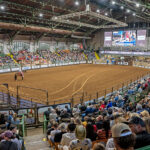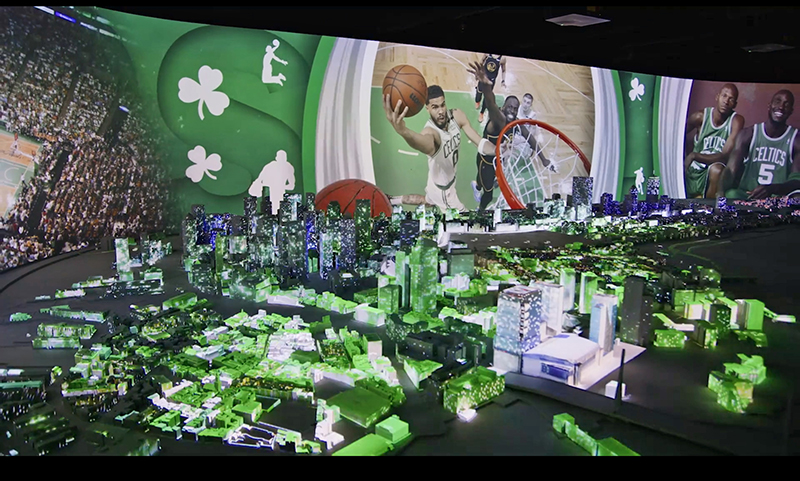
Part of the View Boston attraction at the top of the city’s Prudential Center, BOSTON 365 is an over 50’ wide 3D scale-model of the city with projection-mapping that dramatically reveals the seasons, spirit, and celebrations that bring Boston to life. To realize this unique and engaging experience, Jack Rouse Associates, part of RWS Global, worked with Lightborne to concept, develop, and execute 12 one-minute-long multi-surface narrative animations to celebrate and highlight different aspects of Boston. The resulting experience is stunning in scope and content, capturing the essence of the vibrant city.
Lightborne is a full-service motion design, animation, editorial, and video production team that has been creating award winning content for over three decades. Their work includes live stage performance content, broadcast TV commercials, web and social videos, retail environments, projection mapping, and brand experiences, making them an ideal fit for the BOSTON 365 project. To better understand the work behind this project we spoke with Ryan McAllister, a Creative Director with Lightborne.
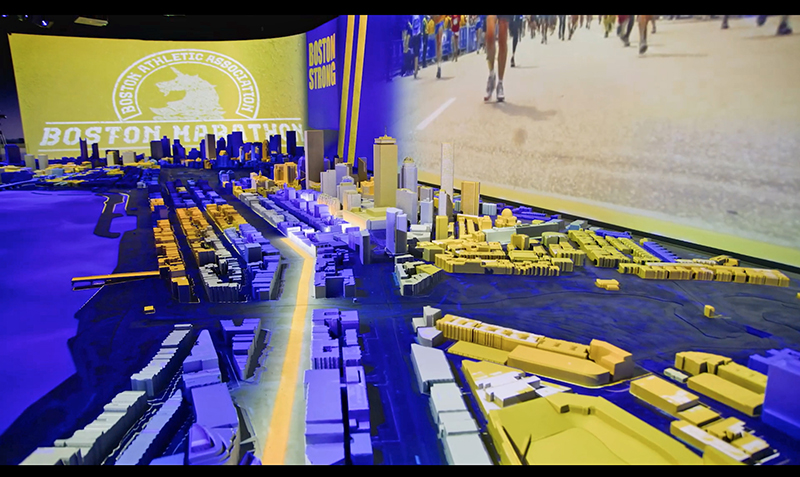
Boston Stories
McAllister first explained that the 3D printed scale-model depicts most of downtown Boston, running along the Charles River with a large back wall behind for set extension and storytelling. The structure of the storytelling is through the 12 one-minute projected story animations. Since the scope of the projection is so big, McAllister comments that, “you can’t do anything super-fast or it’s really jarring to people in the room. So, we had to allot a few seconds at the beginning and end of each individual show to get us to an ‘in and out’ state that made sense. We created these interstitial looks that just do day-to-night kind of things that can be used to thread between the different shows. Because the stories were broken down into three categories. There’s the spirit of Boston, the celebrations around Boston, and the seasons of Boston. The spirit is all the stuff like sports and arts. The celebrations were all the major events like the St. Patrick’s Day parade, the Boston Marathon, and their pride celebration.” For the seasons, there is snow falling, leaves blowing, flowers blooming, and even holiday lights twinkling. So, with such diverse topics that in and out element is important. “If you go from sports, straight into, say, springtime around Boston, it’s kind jarring, you are like, ‘What’s going on here?’ I think we did a really good job of making sure that by the end of each one-minute show, you felt like you had some closure on the little micro story that we told you.”

A Room with Multiple Views
McAllister also says, “Another creative challenge was how do you tell a story, a narrative, in one minute, on a massive canvas like this, where you know that people aren’t going to be seeing it all from one angle? Telling a story on such a wide canvas is always a challenge to direct people to look where you want them to. We’ve done a lot of traditional projection mapping shows, where you usually have an audience that’s looking at whatever you are projection mapping from one angle. Then you can get away with a lot of cool anamorphic design gags where you’re playing with perspective. And that’s the magic of projection mapping that people have come to know and love. But with this project, you never know where somebody is going to be viewing it at. They’re spread across a room that is 50’ wide. So, we had to rethink and relearn all of our gags. And in this case, veering into more of a creative technical challenge was, how do we do that and still make sure that it’s an interesting thing to look at from anywhere in the room and some people aren’t getting a weird skewed image. We had to invent or rethink how we were going to approach that. And the way we did it is by taking the whole model and doing an unwrapped UV of every surface of the model and laying it out so that we were more treating it like one; it was almost like we were remaking it in 3D live as opposed to relying on perspective gags.” They ended up settling on six very, very high-res rasters of an unwrapped version of Boston. So, every single tiny individual building, basically each wall, got turned into a straight-up polygon.
Certainly, as noted, beyond the enormous size of the model itself, the engagement of the experience is very much the dynamic projection mapping. Being that it is the core of the storytelling that allows the audience to experience some of the iconic places and events around Boston, with the entire back wall surface behind the model as well as the projections onto the buildings and streets of the model, it is easy to understand how important it was to account for the multiple viewing points in the room.
“On the massive flat ribbon wall that runs along behind the model,” describes McAllister, “is where we did a lot of our main storytelling by using imagery, footage, and animation about Boston. But at the same time, we wanted to always make sure that we were tying that into something happening on the model. How do we thread visual elements from the storytelling on the wall down into the model in a way that makes it feel compelling. Especially if we’re focusing on a landmark that is reflected in the 3D printed model, we wanted to make sure that it was super obvious that we’re drawing everybody’s attention, no matter where they are in the room, to that part of the model. It was interesting to figure out how to do that, because again, a lot of that relies on perspective. So how do you do that in a way that doesn’t look wrong? We had to flatten everything out and then rebuild it live to make it look correct from no matter where you’re seeing it.”
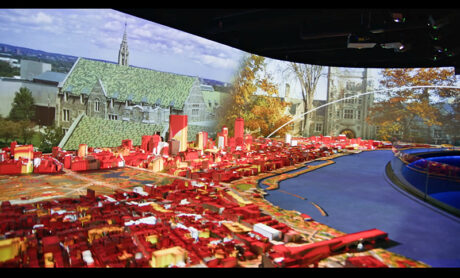
Printed Precision
The method of creating the actual model helped Lightborne be meticulously accurate in their projection mapping. McAllister explains, “I think something that worked out really well with this project is that it was a 3D printed model. There weren’t as many pain points as working on something that was going to be hand built. Having a 3D printed model that we could use to do our animation off of meant we knew that we weren’t going to be inches off when we went to install this thing from a projection mapping standpoint. It was precise. We were working hand-in-glove with FrankNDesign, the team who were designing and doing the 3D printing, and we were constantly getting updated STLs from them and adjusting stuff. And they worked with us as well. Creative choices had to be made about how much detail do we put on this model versus how much detail do we put in as content? You want to make sure the model didn’t have so much detail in it that it was going to be creating too many shadows for us to do anything that looked cool on it. So, it’s a constant dialogue between all of the partners when we’re doing a project that’s like this.”
He continues, “And then we’d have to have conversations between us, the model makers, and the projectionists, because we needed to know, ‘Hey, can we actually boost the resolution on these projectors that are going to be pointed at this thing?’ There are 31 projectors on this model, and the resolution varies across it because you have to pick and choose how much resolution you want to throw at certain things. And the throw distance was so short that we all had to be talking to each other constantly to make sure that we weren’t designing something that was just never going to read right on the model. We used tools like Frame.io to send dailies and designs and tests back and forth to each other. We used Unreal Engine to create a virtual model of a 3D workflow pipeline to test the projection mapping. Then we could send that around to everybody, and if they had VR goggles, they could pop those on and look at it in situ.”

The Technology
The 31 projectors, supplied by systems integrator Electrosonic, were 10 Christie DWU960-iS and 21 DWU960ST-iS. Christie Mystique is used for the image alignment and the show control system is Medialon Showmaster Pro. The files are being played back via 7thSense Infinity Delta media servers. “The servers were from a company called 7thSense, which was new for us because typically when we do projection mapping it’s either on a disguise server or a Green Hippo. But everything went pretty smoothly. It was a little bit of a reworking on our end about how we were going to go about it, but we talked with the 7thSense guys quite a bit and it worked out very well. It is all about communication on a project this massive, there are so many different technical players. Everyone involved were real pros and even though this was a unique project for all of us, it was like a culmination of a lot of other challenges that we’ve had to solve on other projects. So, we all had a sort of shorthand that we could use when talking to each other.”
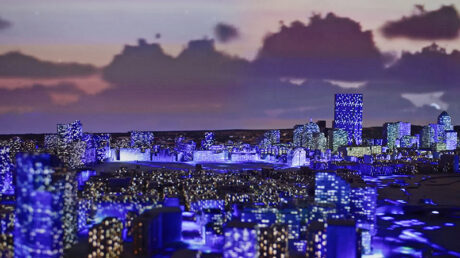
Planning and Communication
The Lightborne team also thought about how, being a permanent installation, BOSTON 365 is likely to use and adapt the narrative content over time when creating the 12 one minute shows. McAllister points out, “One of the interesting problems to solve was that even though ideally everything would run as a 12-show loop, it would almost never be run in an ideal scenario. What happens is they select individual one-minute shows and will show three, four, or five different ones, in different loops, depending on the day and the crowd volume. They need to keep the crowd moving through the entire experience, not just stopped at the model display. So, something we had to consider when we were making the one-minute shows was that we couldn’t have a linear narrative continuity go through all of them. They needed to be self-contained stories, but still all reference each other in subtle ways so that any one of them could be played back to back to any other one and it wouldn’t be totally jarring to see it in any order. From a creative side, that was one of the important considerations, figuring out how to tell 12 unique stories that all have some sort of narrative connection but still be self-contained.”
As for why Lightborne was right for this project, McAllister replies, “What we bring to projects like this is not only technical prowess but a real ability to communicate with all of the technical partners. Something like this is very complicated, very layered and sort of an opaque process, that we understand. That combined with our ability to bring visual storytelling at a very high level. We have a lot of experience doing events, doing visual content for live experiences, and we know how to tell a story. Plus our ability to move quickly and dissect hard creative and technical challenges, that is what we do at Lightborne very well. We’re also excited to tackle new stuff. When we got the RFP for this, I had a hungry look in my eye, I think, because it was such an interesting thing to figure out how to do. I always say, ‘turn the problem 45 degrees or turn your mind 45 degrees and try to figure out a different way to approach the problem.’ That is what we do every day at Lightborne.”
“But I also want to say that for this project, it was a whole team of people, not only everyone at Lightborne but all the technical and creative partners,” emphasizes McAllister. “Managing all of the intricacies of a project like this is really a huge lift because the creative is the tip of the iceberg. It is the thing that you’re actually seeing, but what’s underneath the surface is all this technical and creative work that went into it. Over two years of conversations and iterations and narrative writing and rewriting and designing and redesigning until we got somewhere that we were all stoked on, and that was going to work.” He concludes, “It was a super cool opportunity to get to do this project. It was a massive team effort working with the client and with everyone at our studio to realize this vision that people will enjoy for years to come, hopefully.”
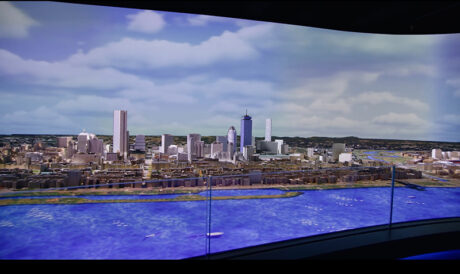
Production Team
Lightborne
- President: Scott Durban
- COO: Angie Fischer
- Creative Directors: Ryan McAllister, Chris Gliebe
- Producer: Austin Winters
- Senior Designers/Animators: Justin Lee, Kurt Koch, Lee Hoffman
- Designers/Animators: Rob Engel, Andy Erb, Duncan Friend, Bryan Johnson, Austin Lutz, Andrew Niehaus, Austin Wydra, Jared Ziegler
- Implementation Specialist: JJ Painter
Creative Partners
- Creative Producer/Project Management: Jack Rouse Associates (RWS Global)
- 3D Model Design: FrankNDesign
- AV Integrator: Electrosonic
- Model Optimization: dandelion+burdock
- Musical Score: Yessian
Lightborne is an industry leading full-service motion design, animation, editorial, and video production team. See more of their work and learn more at https://lightborne.com.
